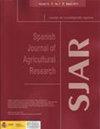不同接穗-砧木组合对柑橘作物生产性能和果实品质的响应
IF 0.8
4区 农林科学
Q3 AGRICULTURE, MULTIDISCIPLINARY
引用次数: 0
摘要
研究目的:解决柑橘品种多样化的问题,以增加果园的品种和盈利能力,使其适应环境变化。研究地区:圣保罗州,巴西东南部的一个亚热带地区。材料和方法:本研究评估了甜橙品种“Rubi”(R)、“Lue Gin Gong”(LGG)和“Valencia Delta Seedless”(VDS)嫁接到“朗布尔”酸橙(RL)和“Swingle”瓜氨酸(SC)上的酚期、热量总和、营养和生产性能以及果实质量。该田间试验在2018-2021年连续生长季节进行。主要结果:不同砧木对不同生育期的影响不大。无论砧木如何,R的收获时间约为开花后245天,LGG的收获时间为402天,VDS的收获时间分别为407天。与SC树相比,嫁接到RL上的Scion品种表现出更大的冠层体积和更大的果实重量、长度和直径,并且由于较低的冠层体积,与SC的组合比RL更高效。R接穗品种表现出比LGG和VDS更好的产量表现和果实着色。LGG/RL、LGG/SC、VDS/RL和VDS/SC组合对果实的理化性质有改善作用。研究重点:这些结果可能有助于规划新果园接穗/砧木组合的多样化,确定用于工业加工和自然消费的双重市场橙色品种,并确定更适合不良气候条件的组合。本文章由计算机程序翻译,如有差异,请以英文原文为准。
Citrus crop performance and fruit quality in response to different scion-rootstock combinations
Aim of study: To address diversification of citrus cultivars to increase the variety and profitability of orchards to adapt them to environmental changes.
Area of study: State of São Paulo, a subtropical region of southeastern Brazil.
Material and methods: The study evaluated the phenological intervals, thermal sum, vegetative and productive performance, and fruit quality of the sweet orange cultivars ‘Rubi’ (R), ‘Lue Gin Gong’ (LGG) and ‘Valencia Delta Seedless’ (VDS) grafted onto 'Rangpur' lime (RL) and 'Swingle' citrumelo (SC). The field experiment was conducted over consecutive growing seasons 2018-2021.
Main results: The duration of the phenological intervals was little influenced by the rootstocks. The harvest time was approximately 245 days after anthesis (DAA) for R, 402 DAA for LGG, and 407 DAA for VDS, regardless of rootstock. Scion cultivars grafted onto RL showed larger canopy volumes and greater weight, length, and diameter of fruits than those of SC trees, and the combinations with SC were more productively efficient than RL due to lower canopy volume. The R scion cultivar presented superior yield performance and fruit colouration than LGG and VDS. The physicochemical quality of the fruits showed improved results with the combinations of LGG/RL, LGG/SC, VDS/RL, and VDS/SC.
Research highlights: These results may be useful when planning the diversification of scion/rootstock combinations for new orchards, identifying dual-market orange cultivars for industrial processing and natural consumption, and determining the combinations that are better adapted to undesirable climatic conditions.
求助全文
通过发布文献求助,成功后即可免费获取论文全文。
去求助
来源期刊

Spanish Journal of Agricultural Research
农林科学-农业综合
CiteScore
2.00
自引率
0.00%
发文量
60
审稿时长
6 months
期刊介绍:
The Spanish Journal of Agricultural Research (SJAR) is a quarterly international journal that accepts research articles, reviews and short communications of content related to agriculture. Research articles and short communications must report original work not previously published in any language and not under consideration for publication elsewhere.
The main aim of SJAR is to publish papers that report research findings on the following topics: agricultural economics; agricultural engineering; agricultural environment and ecology; animal breeding, genetics and reproduction; animal health and welfare; animal production; plant breeding, genetics and genetic resources; plant physiology; plant production (field and horticultural crops); plant protection; soil science; and water management.
 求助内容:
求助内容: 应助结果提醒方式:
应助结果提醒方式:


